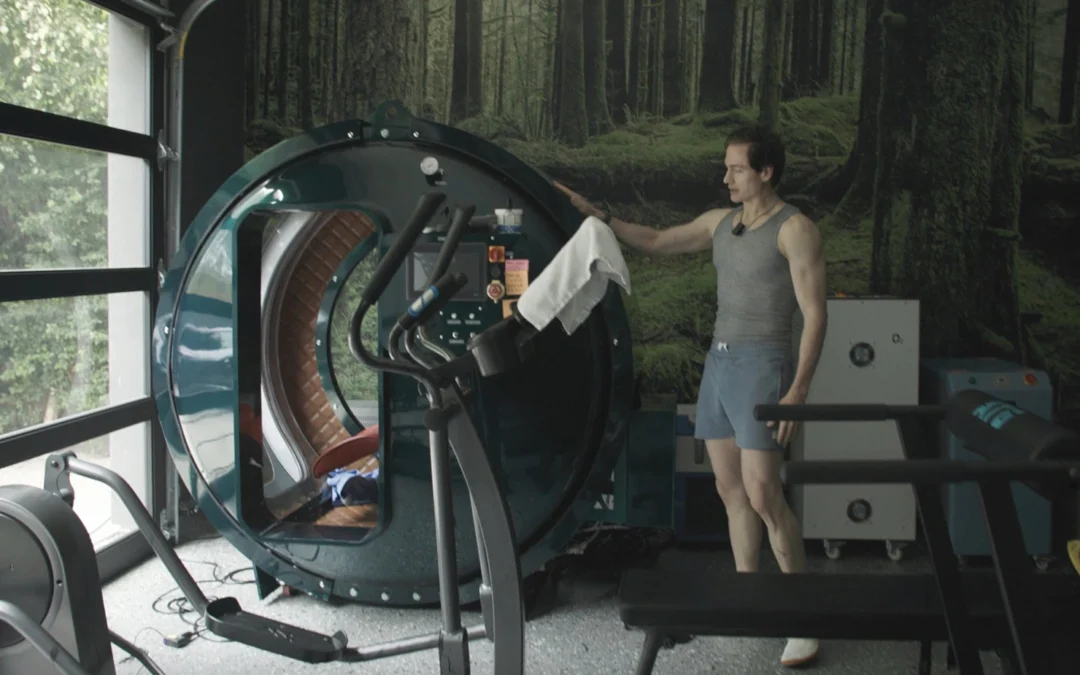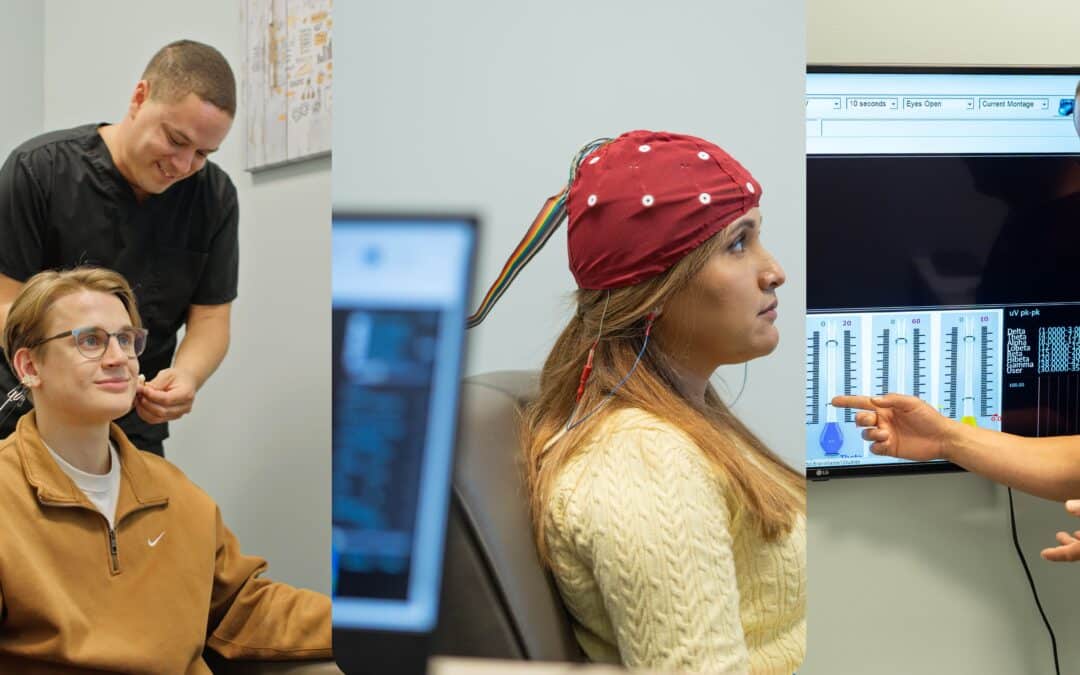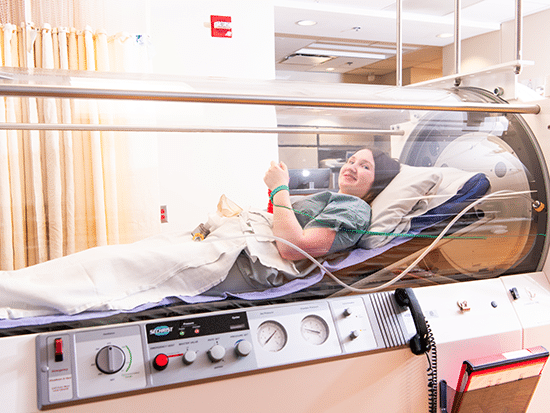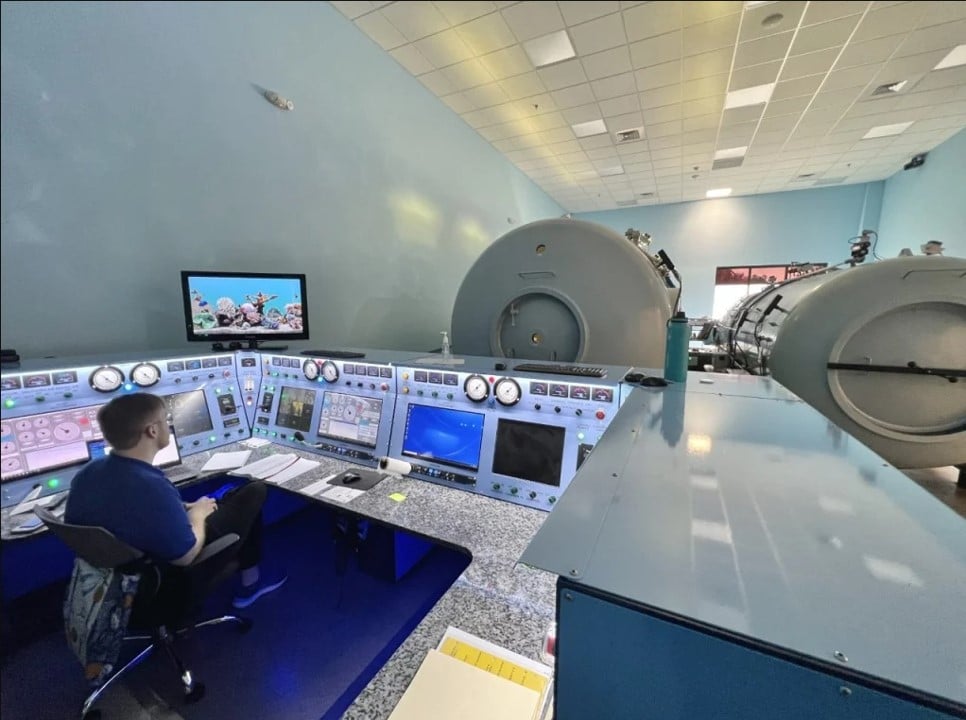Stroke Recovery: Britney’s Recovery with HBOT
In 2018, when Britney Thomas was 14 years old, she suffered a brain rupture in the middle of the night, causing a stroke and brain bleed. Unknowingly, Britney was born with an arteriovenous malformation — commonly known as an AVM — where an abnormal connection between arteries and veins is present and, like a ticking time bomb, can rupture at any point and cause bleeding in the brain.
“She had no symptoms — the wild thing is that you have no idea that you have an AVM until the worst happens,” said Melinda Thomas, Britney’s mother. “She was a totally normal ninth grader. She loved to dance.”
Rushed to the hospital in her hometown of Huntsville, Alabama, Britney’s AVM was too large to remove with surgery; but it was determined that radiation treatment would be the best course. While radiation successfully shrunk her AVM fully away, there was radiation damage left to the surrounding brain tissue. Britney used a wheelchair and was suffering from the loss of her peripheral vision — both results of the stroke she suffered.
“We built really close relationships with other families of children with traumatic brain injuries, and we knew of another family whose child had lingering stroke effects similar to Britney’s,” Melinda recalled. “Hyperbaric oxygen treatment kept coming up as the best option to help heal the radiation damage, and after much research, our radiologist referred us to theUniversity of Alabama at BirminghamHospitalfor treatment.”
Hyperbaric oxygen treatment at UAB Medicine
Hyperbaric oxygen treatmentis a medical treatment administered by delivering 100 percent oxygen at pressures greater than atmospheric, or sea level, pressure to a patient inside an enclosed chamber environment. Hyperbaric medicine and its three chambers are housed within theDepartment of Emergency Medicine. In therapy, pressure administered to patients is typically two to three times greater than normal atmospheric pressure, causing the blood, tissue and muscles to carry larger amounts of oxygen — up to 20 times normal concentration. By this application, wounds, particularly hypoxic and infected wounds, have more oxygen available for the healing process.
“What hyperbaric medicine does is utilize oxygen like a drug,” explained Matthew Kelly, M.D., associate professor of emergency medicine in the UABMarnix E. Heersink School of Medicineand co-medical director of Wound Care and Hyperbaric Medicine. “Oxygen has certain effects and certain side effects, and the way you dose oxygen like a drug is with pressure through these hyperbaric chambers, which are basically pressure vehicles in order to deliver oxygen and help heal wounds — non-healing, poorly healing and complications of radiation.”
According to Kelly, the underlying theme of what hyperbaric treatment is often used to treat is ischemia, which is an inadequate blood supply to an organ. Hyperbaric therapy can reverse ischemia and in certain instances can increase the blood vessel density to in essence reverse some of the ischemic problems, especially relating to radiation; treatment can actually increase the vascular density to a lot of radiated tissue by 80 percent.
For patients like Britney, the intense oxygen pressure helps heal damage to their affected tissues, and hyperbaric therapy is also primarily diagnosed for compromised grafts and flaps, problem wounds, osteomyelitis, gas gangrene, necrotizing soft tissue infection, crush injuries, carbon monoxide poisoning, air embolism, thermal burns, and more.
“A big part of this is healing wounds for patients who have had wounds for years and can’t get them healed — diabetic foot wounds, radiation damage. It can really help keep people out of the hospital and get them on a road to a more complete recovery,” Kelly said. “Britney’s is a fascinating case because, prior to treatment, she was not walking or talking. Now she’s doing both. This treatment is really remarkable.”
Treatments for chronic conditions may be repeated over days or weeks. The average patient could undergo 20-40 treatments in the hyperbaric chamber, while more advanced cases like Britney’s could require up to 120 treatments.
Fitting of a missing puzzle piece
Britney began her journey of 120 treatments in the summer of 2022 and completed her last treatment in September 2023. While her treatment course was longer than most, Melinda notes that their daily and weekly trips from Huntsville to UAB became routine and enjoyable, and her continued progress and healing made the process one that had to be seen to be believed.
“When we first began her treatments, I was bringing her in a wheelchair because she couldn’t walk, and she couldn’t see on her right side due to the stroke,” Melinda recalled. “Today she’s walking to these appointments. Her gait has improved and her legs are stronger. She’s seeing color and her vision has improved.”
Melinda and Britney, now 19 years old, share a goal of getting her back to the things she loves, like dancing and being with friends. She has passed her driver’s permit test and has her eyes set on getting her driver’s license. With gratitude for the treatments completed at UAB, one of the Thomas family’s biggest takeaways has been a sense of community.
“This environment has helped us mentally, too — we can see others walking a similar path and know that we are not going through this alone,” Melinda said. “We’ve met people during our treatments and built relationships. There are many families I still follow up with. For those with a loved one recovering from a TBI, hyperbaric medicine would definitely be a first choice for recovery and healing.”
Cited By: The University of Alabama at Birmingham
For those affected by stroke and exploring avenues for rehabilitation, Britney’s story illuminates the path to recovery and the possibilities that HBOT offers. Our clinic specializes in hyperbaric medicine, providing a supportive environment and state-of-the-art treatments for stroke recovery. We invite patients and their families to learn more about how HBOT can be a part of their healing journey. Reach out to us to discover how we can help you or your loved one take the next steps towards recovery and regaining independence.
Read More

Can Hyperbaric Oxygen Therapy (HBOT) Reverse Aging?
Inside Bryan Johnson’s $2M Longevity Regimen—and What It Means for YouImage of Bryan Johnson next to his home ZEUGMA hyperbaric chamber (2.0 ATA) made by HPO TECHBiohacking, Billionaires & Breakthroughs What if you could reverse aging—not with surgery or...

Longevity Is No Longer a Luxury—It’s the Future of Wellness
And it’s already arrived in Durham. Around the world, luxury resorts are evolving into full-fledged longevity destinations. They offer more than ocean views and spa treatments—they offer designed to help guests live longer, sharper, more vibrant lives. This is not a...

Neurofeedback for Substance Use Disorders: A Brain-Based Path to Recovery
Substance Use Disorders Begin in the Brain Substance Use Disorders (SUDs) are not just behavioral problems — they are neurological conditions. Prolonged substance use changes how the brain functions. These changes impact critical areas that control reward,...


